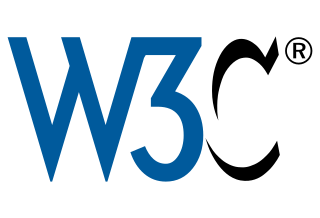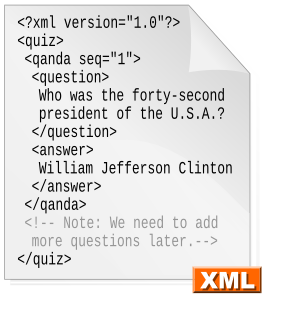
The Document Object Model (DOM) is a cross-platform and language-independent application programming interface that treats an HTML, XHTML, or XML document as a tree structure wherein each node is an object representing a part of the document. The DOM represents a document with a logical tree. Each branch of the tree ends in a node, and each node contains objects. DOM methods allow programmatic access to the tree; with them one can change the structure, style or content of a document. Nodes can have event handlers attached to them. Once an event is triggered, the event handlers get executed.

Hypertext Markup Language (HTML) is the standard markup language for creating web pages and web applications. With Cascading Style Sheets (CSS) and JavaScript, it forms a triad of cornerstone technologies for the World Wide Web.
XSLT is a language for transforming XML documents into other XML documents, or other formats such as HTML for web pages, plain text or XSL Formatting Objects, which may subsequently be converted to other formats, such as PDF, PostScript and PNG. XSLT 1.0 is widely supported in modern web browsers.
The Resource Description Framework (RDF) is a family of World Wide Web Consortium (W3C) specifications originally designed as a metadata data model. It has come to be used as a general method for conceptual description or modeling of information that is implemented in web resources, using a variety of syntax notations and data serialization formats. It is also used in knowledge management applications.
XSD, a recommendation of the World Wide Web Consortium (W3C), specifies how to formally describe the elements in an Extensible Markup Language (XML) document. It can be used by programmers to verify each piece of item content in a document. They can check if it adheres to the description of the element it is placed in.
XML Linking Language, or XLink, is an XML markup language and W3C specification that provides methods for creating internal and external links within XML documents, and associating metadata with those links.
Web standards are the formal, non-proprietary standards and other technical specifications that define and describe aspects of the World Wide Web. In recent years, the term has been more frequently associated with the trend of endorsing a set of standardized best practices for building web sites, and a philosophy of web design and development that includes those methods.
In computer hypertext, a fragment identifier is a string of characters that refers to a resource that is subordinate to another, primary resource. The primary resource is identified by a Uniform Resource Identifier (URI), and the fragment identifier points to the subordinate resource.
XML namespaces are used for providing uniquely named elements and attributes in an XML document. They are defined in a W3C recommendation. An XML instance may contain element or attribute names from more than one XML vocabulary. If each vocabulary is given a namespace, the ambiguity between identically named elements or attributes can be resolved.
Speech Recognition Grammar Specification (SRGS) is a W3C standard for how speech recognition grammars are specified. A speech recognition grammar is a set of word patterns, and tells a speech recognition system what to expect a human to say. For instance, if you call an auto-attendant application, it will prompt you for the name of a person. It will then start up a speech recognizer, giving it a speech recognition grammar. This grammar contains the names of the people in the auto attendant's directory and a collection of sentence patterns that are the typical responses from callers to the prompt.

SPARQL is an RDF query language—that is, a semantic query language for databases—able to retrieve and manipulate data stored in Resource Description Framework (RDF) format. It was made a standard by the RDF Data Access Working Group (DAWG) of the World Wide Web Consortium, and is recognized as one of the key technologies of the semantic web. On 15 January 2008, SPARQL 1.0 became an official W3C Recommendation, and SPARQL 1.1 in March, 2013.
RDFa is a W3C Recommendation that adds a set of attribute-level extensions to HTML, XHTML and various XML-based document types for embedding rich metadata within Web documents. The RDF data-model mapping enables its use for embedding RDF subject-predicate-object expressions within XHTML documents. It also enables the extraction of RDF model triples by compliant user agents.
Terse RDF Triple Language (Turtle) is a syntax and file format for expressing data in the Resource Description Framework (RDF) data model. Turtle syntax is similar to that of SPARQL, an RDF query language.
An RDF query language is a computer language, specifically a query language for databases, able to retrieve and manipulate data stored in Resource Description Framework (RDF) format.
Semantic Interpretation for Speech Recognition (SISR) defines the syntax and semantics of annotations to grammar rules in the Speech Recognition Grammar Specification (SRGS). Since 5 April 2007, it is a World Wide Web Consortium recommendation.
In computing, a CURIE defines a generic, abbreviated syntax for expressing Uniform Resource Identifiers (URIs). It is an abbreviated URI expressed in a compact syntax, and may be found in both XML and non-XML grammars. A CURIE may be considered a datatype.
N-Triples is a format for storing and transmitting data. It is a line-based, plain text serialisation format for RDF graphs, and a subset of the Turtle format. N-Triples should not be confused with Notation3 which is a superset of Turtle. N-Triples was primarily developed by Dave Beckett at the University of Bristol and Art Barstow at the World Wide Web Consortium (W3C).
Extensible Hypertext Markup Language (XHTML) is part of the family of XML markup languages. It mirrors or extends versions of the widely used Hypertext Markup Language (HTML), the language in which Web pages are formulated.
A document type declaration, or DOCTYPE, is an instruction that associates a particular SGML or XML document with a document type definition (DTD) (for example, the formal definition of a particular version of HTML1.0 - HTML 4.0). In the serialized form of the document, it manifests as a short string of markup that conforms to a particular syntax.


